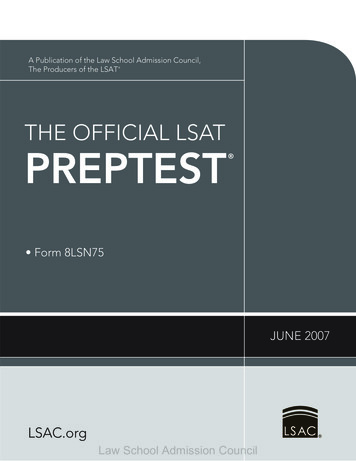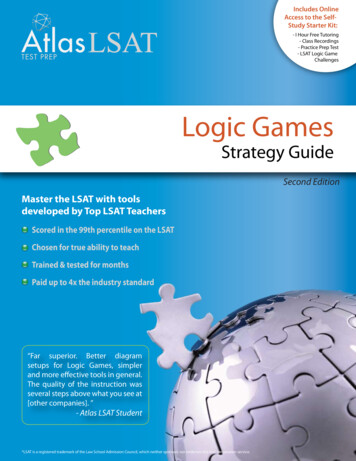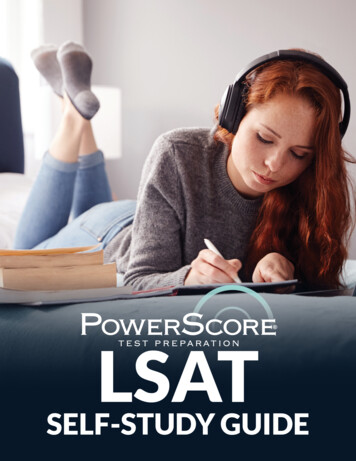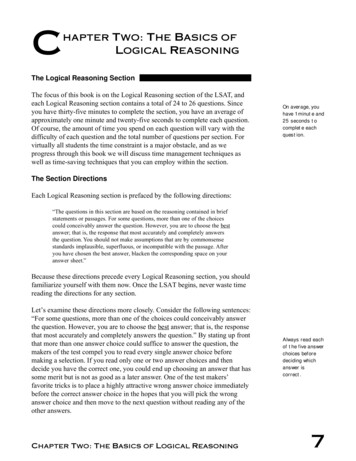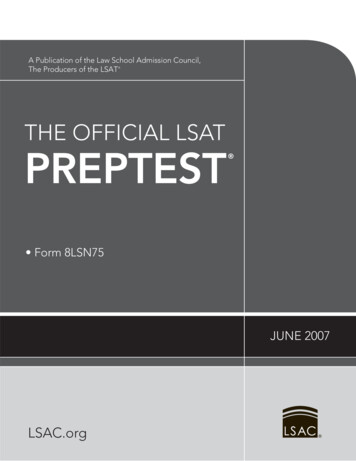
Transcription
The DigitalLSAT What You Need to KnowLSAT is a registered mark of the Law School Admission Council, Inc.,which neither sponsors nor endorses this product.
THE DIGITAL LSAT: INTRODUCTIONThe digital administration of the LSAT constitutes the biggest change to the exam in more than25 years. Since its inception in 1945, the LSAT has been a paper-and-pencil test, its recognizableanswer grid replete with columns of little bubbles to be filled in by No. 2 pencil only. Starting inJuly 2019, the LSAT will be administered on tablets equipped with software exclusivelydesigned to deliver the test. This change has some test takers excited and makes others wary. Aneven larger percentage, however, simply have questions, and those are what this short volume isdesigned to answer.The Digital LSAT: What You Need to Know will first lay out the details of the digital testadministration: what’s changing and what isn’t, when the changes are coming, and briefly, why.Next, the book digs into the tools available in the digital interface and passes on some tips fromour LSAT experts who’ve used the new software. Finally, you’ll find Kaplan’s advice for thebest ways to prepare for the digital test.At Kaplan, we believe that the change to a digital format provides opportunities for the welltrained test taker to excel. There are new and unique tools to learn about and a few changes to thetest day experience to get ready for, but your key to success on the digital LSAT is preparation,and that’s why we’re here.Images of the Digital Familiarization Tool are used with permission of LSAC. This is not an official Law SchoolAdmission Council simulation, but it provides an experience intended to be similar to the digital LSAT.1
THE DIGITAL LSAT: FACTS AND DATESThe upcoming implementation of the digital administration of the LSAT is the result of severalyears of study and design by LSAC, the organization that writes and administers the exam. Themost obvious change to the test taker experience will be in the “hardware.” The test booklet andscore sheet are out. The tablet and digital interface are in.Figure 1.1 Digital LSAT interface LSAC.orgPart II of this book will examine the details of the digital interface and provide strategies to helpyou take full advantage of the new tools. That said, what’s under the hood—the test’s sectionsand questions—isn’t seeing the same radical change. To allay potential trepidation and to betterfocus on what is new, first take a look at what remains the same between the paper LSAT and itsnew digital counterpart.What’s Not Changing1. The Test Sections and QuestionsSince 1992, the LSAT has had four scored sections: two of Logical Reasoning, one of ReadingComprehension, and one of Logic Games (which the LSAT calls Analytical Reasoning). Overthe past 10 years, the number of questions in each of those sections has been almost unchanged.These section types and the number of questions in each will remain intact under the digitaladministration.2
Section# of Qs TimeLogical Reasoning24 - 26 35 minutesReading Comprehension26 - 28 35 minutesAnalytical Reasoning (Logic Games)22 - 24 35 minutesExperimental (unscored - any type)22 - 28 35 minutesTable 1.2 LSAT section breakdownWithin those sections, the types of questions, games, and reading passages will also remainunchanged. In short, you could drop a paper-and-pencil LSAT into the digital format, and viceversa, and as far as the content goes, you would not know the difference.Notice that there is also an unscored experimental section, which the testmaker includes toevaluate questions for future LSATs. It, too, remains unchanged from the paper-and-penciladministration. The experimental section may appear as any one of the three scored sectiontypes, and it may appear at any point in the test.LSAT StrategyYou will not know which section is experimental and you should do your best on all fivesections. It is not in your interest to try to guess or figure out the position of the experimentalsection during the test.The LSAT will continue to have an unscored Writing Sample, but it will no longer beadministered as part of the test day experience. You'll learn more about the new asynchronousWriting Sample in the "What IS Changing" section that follows.2. How the Test Is ScoredLSAT scores are determined entirely by the number of questions a test taker correctly answers.There is no wrong answer penalty, and every question counts equally. This was true for the test’spaper-and-pencil format and will continue to be for the digital version.LSAT StrategyDon’t leave any bubbles blank. Select an answer for every question even if it is a guess.The testmaker converts raw scores (the number of correct answers) to the well known 120-180score through a process called scaling that ensures that scores from all test administrations withina three-year window are comparable. The schools to which you apply also see your percentilerank, or the proportion of test takers you scored better than.3
Raw ScoreScaled 320th3713910thTable 1.3 Typical LSAT Scoring ScalePrepTest 64, LSAC.orgThe LSAC is undertaking rigorous testing to ensure that digital administrations can be scoredfairly and accurately in relation to paper-and-pencil administrations. You may discover apersonal preference for one format over the other, but rest assured that there will be no “built in”score advantage for either digital or paper-and-pencil test takers.DIGITAL DETAIL - The JULY 2019 TESTAs part of LSAC’s comparison testing of the digital and paper formats, roughly half of the testtakers for the July 15, 2019 LSAT administration will take the test on paper while the other halftakes the test digitally on tablets. Test takers will not know which format they will use until testday. Because of this uncertainty, LSAC will allow test takers for this administration only tocancel their results after seeing their scores. All subsequent LSAT administrations will be 100%digital, and test takers will not be able to cancel once scores have been released.3. Test Registration and (Most) Test Day RulesAt least for now, LSAC is making no changes to its policies and procedures for registering andchecking in for the LSAT test. You will still need to register by the deadline associated with eachadministration. Test dates and registration deadlines can be found at e-dates. You will also need to upload your passport photo by a4
designated date and download your admission ticket prior to going to the test site. admission-requirements for all requirements.Likewise, the LSAC has not announced any changes to its rules about what test takers may andmay not bring to test sites. See es for thespecifics. Note: July 2019 test takers should bring sharpened No. 2 pencils. If your test site isgiving paper-and-pencil tests, you’ll be ready. If your test site turns out to be a digital test site,you will not need to use pencils, as digital test takers will be given a pen to use on scratch paperand a stylus to use for highlighting and underlining on the tablet.What Is ChangingThe biggest change entailed in the digital administration of the LSAT is, of course, the changefrom paper to tablet both to deliver the questions and to capture test takers’ responses. You canget to know the digital interface through tutorial videos and practice at the appropriately namedfamiliar.lsac.org/. Broadly stating that the test is now on a computer, however, masks severalsubtle but important differences in test takers’ test day experiences.1. Pre-Test ProceduresBefore the administration of the paper-and-pencil LSAT, test takers heard their proctors read alist of rules aloud and then, without opening their test booklets, were instructed to remove theanswer grid and fill in their personal information using bubbles for their name, date of birth, andso on. Now, pre-test instructions will be delivered via a video, and personal information will beentered into the tablet.2. Scratch PaperFor the paper-and-pencil LSAT, test takers were given no additional scratch paper and wereforbidden from bringing any to the test site. Well prepared test takers practiced using the space intheir test booklets to take notes, draw diagrams, or flag questions they skipped.Now, each test taker will be provided with a booklet of blank paper (you still may not bring anyfrom outside the test site) along with the digital tablet. It will be important for digitaladministration test takers to practice taking notes and drawing Logic Games sketches on paperseparate from the test questions, and even to think about details such as where they want to keepthe tablet and scratch paper on the desk as they work. Kaplan LSAT experts provide somevaluable strategies and tactics for scratch paper use in Part II of this book.DIGITAL LSAT STRATEGYIf you are practicing for a digital administration of the LSAT using paper PrepTests from LSAC,start training yourself to take notes on separate sheets of scratch paper. Think of the paperPrepTest as a virtual tablet on which you can highlight or underline, but on which you cannotwrite or draw.5
3. Bubbling In Your AnswersThis is one area in which the digital interface appears to be a pure win. On the paper-and-pencilLSAT, you, as a test taker, could circle or cross-out answers in the test booklet, but you did notget credit for an answer unless you accurately bubbled it on the answer grid. There were severalrisks involved in this process. You might fail to completely fill in the bubble, or you could“double-bubble,” both of which would cause the machine scoring the test to register no responsefor that question. Even worse, you might get your bubbles off by one question—for example,bubbling the answer to Question 5 on the line for Question 6. If you didn’t catch that mistakequickly, it could lead to a disaster in which all of the subsequent questions for that entire sectionwere mis-bubbled.Figure 1.4 No more grid errors!In the digital interface, your only concern is clicking on the correct answer to start with. If thecorrect answer for Question 2 is (E), let’s say, all you have to do is click (E) to the left of theanswer choice. The tablet will record your answer choice for each question and mis-bubbling is athing of the past.6
Figure 1.5 Digital interface answer selectionLSAC.orgYou can even see questions for which you have not yet selected a final answer by glancing at the“bubble bar” at the bottom of the screen.DIGITAL LSAT STRATEGYThe new digital interface has a FLAG tool that allows you to note questions to which you wantto return, time permitting. Get used to flagging questions you skip and those for which youchoose an answer but feel that another look will increase your confidence that you’ve made theright choice.4. Time Keeping and the 5-Minute WarningFor the paper-and-pencil LSAT, proctors are also the official timekeepers for each section. Theyverbally announce “Begin working on Section X,” and usually, write the start time for thesection on the board at the front of the room. They also verbally announce “Five minutesremaining” and “Pencils down” for each section. On the digital LSAT, the proctor will tell you toget ready for a section to begin, and then they will press a button that starts the section for all ofthe tablets in the room. There is a countdown timer in the tablet interface that can be hidden ifyou find it distracting.7
Figure 1.6 Countdown timer: on and off LSAC.orgWhen five minutes remain in the section, test takers will see a pop-up to that effect. They willnot be able to proceed in the section until they actively close the 5-minute-warning pop-up. Fromthat point until the end of the section, test takers will not be able to hide the countdown timer.When time expires, the section will automatically close. There will be no way for test takers toadd or change any answers for that section once time has expiredDIGITAL LSAT STRATEGYWhen you have less than five minutes remaining in a section, take a moment to click an answer(even if it’s a guess) to each unanswered question you have remaining. Check your flaggedquestions to decide which you want to go back to review in the time remaining.5. The Writing SampleFor decades now, test takers at paper-and-pencil administrations of the LSAT have had tocomplete a 35-minute writing sample after the end of their multiple-choice LSAT test. Theywere given a separate booklet with a prompt for the Writing Sample and were expected to handwrite their responses on a two-sided sheet of lined paper within the booklet. Well, no more.Starting with the June 3, 2019 administration of the exam (the last 100% paper-and-penciladministration at test sites), and continuing for all subsequent administrations, test takers willcomplete the Writing Sample online at a time of their own convenience within one year of theirofficial test date. And, to the delight of many test takers, they'll be able to type their responses.The timing will be the same, so be sure you’ll have an uninterrupted 35 minutes in which tocomplete your Writing Sample essay.8
The Writing Sample is not scored, and it will not be for the digital administration either. Lawschool admissions officers at many schools, however, tell Kaplan that they read all of theirapplicants’ Writing Sample responses and give them serious consideration as part of theirholistic evaluation of each applicant. Should you decide to take the LSAT more than once, youwill not have to complete another Writing Sample.Accessibility and Accommodations on the Digital LSATAccessibilityThe LSAC lays out the accessibility features available on the tablets used for administering thedigital LSAT in its FAQ here: his is LSAC's verbatim FAQ entry on Accessibility as of April 4, 2019:“The Digital LSAT is administered on a Microsoft Surface Go tablet, and has a 8.3125” x 5.5”screen on which text is displayed. The following features will be automatically available for theDigital LSAT Test: StylusUser-adjustable font sizes (8, 10, 12, 15, 18, and 27-point font)Adjustable line spacingBrightness adjustmentHigh-contrast textMagnification gesturesColor inversionColor filters to assist a wide range of issues, including deuteranomaly (reduced sensitivity togreen light), protanomaly (reduced sensitivity to red light), and tritanomaly (reduced sensitivityto blue light), as well as light sensitivity and visual preferencesGray scaleAll candidates will also have access to scratch paper and a pen provided by LSAC for use withthe Digital LSAT. LSAC will also provide a stylus that can be used to underline and highlighttext on the tablet.”AccommodationsLSAC has made clear that it will honor accommodated testing for the digital administrations ofthe LSAT just as it has on paper-and-pencil versions. In fact, some accommodations—such asalternative score sheets or larger font sizes—may be built-in features of the digital interface.Nevertheless, LSAC encourages students to apply for all appropriate accommodations. This isespecially important for anyone taking the July 15, 2019 administration, as test takers will notknow until they arrive at the test site whether they are receiving a paper or digital version of thetest. For more information about accommodated testing and all of the details about how to applyfor accommodations, see takers-disabilities.LSAC addresses questions about accommodations on the digital test in their at.9
UPCOMING LSAT ADMINISTRATIONSDATE & TIMEFORMATREGISTRATIONMonday, June 3, 2019, 12:30 pm100% Paper;Online writing sampleWednesday, April 24,2019Monday, July 15, 2019, 12:30 pm50% Paper, 50% Digital;Online writing sampleTuesday, June 4, 2019Saturday, September 21, 2019, 8:30 am100% Digital;Online writing sample[TBA]Monday, October 28, 2019, 12:30 pm100% Digital;Online writing sample[TBA]Monday, November 25, 2019, 12:30 pm100% Digital;Online writing sample[TBA]Table 1.8 2019 LSAT test dates and formats LSAC.org10
THE DIGITAL LSAT: STRATEGIES ANDTACTICSThe purpose of this section is to illustrate and explain some of the ways you can use the newdigital LSAT interface to your advantage. Using the new tools judiciously will help you managetime and put points in your pocket on test day. Before you dive into this part of the book, pleasewatch the tutorial videos posted by LSAC to help test takers get acquainted with the new testformat: familiar.lsac.org/. After you’ve watched the videos and experimented a bit with thegeneric practice questions, come back to this chapter to see the advice of Kaplan’s veteran LSATexperts. Then, apply your new skills and strategies to the Section Practice back on the LSACwebsite.The strategies and tactics you’ll learn here focus exclusively on using the digital interface. Ofcourse, success on the LSAT requires mastery of the content and skills involved in answering thequestions as well. If you’re looking for more help and practice with all aspects of the test, visitwww.kaptest.com/LSAT for everything from free events and books to live in-person and onlinecourses. We’ve got your back on all things LSAT.The Digital LSAT InterfaceHere's a screenshot of a generic question, taken from the Digital LSAT interface. We've labeledthe buttons to show you what each of them does.11
Figure 2.1 Digital LSAT screen layoutLSAC.orgHere’s what we’ve labeled along with a few strategy notes that apply to all three scored sectionsof the test.1. The “Directions” button will take you back to the Directions slide at the start of the testsection. When you’re on the Directions page, this button changes to say “Questions.” If you clickthe button while you’re on the Directions page, it will take you back to the last question at whichyou were looking.2. These icons activate the underlining and highlighting tools (there are three highlighter colors),and an eraser tool to remove underlines or highlights you’ve made.PRACTICE TIPOn the official LSAT, you will have a stylus that makes underlining and highlighting easier andmore accurate than it may be with your finger (if you’re using a tablet without a stylus); thestylus will almost certainly feel more responsive than a mouse (if you’re practicing on a laptop).3. These three tools allow you to adjust font size (four options), line spacing (three options), andbrightness (a slider).12
PRACTICE TIPPractice using these tools—preferably on a tablet—until you’re familiar and comfortable withthem. That way, you’ll know from the get-go how you want to adjust the view for each section ofthe test. Note: The LSAC familiarization tool is web-based, so no matter how you use it, it willnot have quite the ease of use or responsiveness of the official test day tablet.4. This is the section timer. It will start at 35:00 and count down to 00:00. For the first 30minutes of the section, you can hide the timer by clicking on the numbers.PRACTICE TIPSome test takers like to see the timer. Others get anxious having the clock in their peripheralvision. There is no right or wrong way to use the timer. Try it out in practice to see what worksbest for you.5. This is where the question’s stimulus or prompt will be. For Logical Reasoning, that meansthe argument or paragraph on which the question is based; for Logic Games, it means the game’ssetup and rules; and, for Reading Comprehension, it means the passage. For passages andparagraphs too long to fit on the screen, there will be a scroll bar that controls just the text in theleft-hand column.6. This column will always have the question stem and answer choices. Clicking a circle to theleft of an answer choice selects that choice as the correct answer. Clicking a circle to the right ofan answer choice will grey-down that choice. Note: You must click a choice from the left-handcircles; greying down four answer choices does not automatically select the correct answer. Thismay look or sound confusing at first, but it's quite intuitive after just a couple minutes ofpractice.DIGITAL LSAT STRATEGYAmong the high-scoring LSAT experts we surveyed about their use of the new digital interface,no feature gained as universally high praise as the “grey down” bubbles. Top scorers on theLSAT develop tremendous acumen and confidence that allows them to eliminate incorrectchoices after one read-through. They all appreciated the added clarity of being able to visuallyeliminate the choice with one click.6a. On questions in which the right-hand column text will not fit onscreen, you’ll see upwardarrows to the right of the answer choices. These allow you to collapse answer choices until thetext no longer requires a scroll bar. Collapsing answers you’ve confidently eliminated will helpyou avoid rereading and confusion.13
Figure 2.2 Collapsible answer choices LSAC.org7. This flag allows you to mark questions. Our LSAT experts used it in two situations. Someflagged questions that they skipped or left unanswered. All of the experts, however, used the flagfor questions to which they wanted to return, time permitting. In some cases, these werequestions for which they had picked an answer, but had low confidence in their choice andwanted to give it one more look. In other cases, these were questions on which the expert hadeliminated (greyed down) two or three of the answers and wanted to come back for a finaldecision on the remaining choices.DIGITAL LSAT STRATEGYStrategic skipping and guessing are important tactics for effective time management on theLSAT. Test experts know that all questions carry equal weight in calculating their final score, sothey avoid wasting too much time on any single question. The flag tool on the digital test is ahuge improvement over any technique available for keeping track of skipped questions in thepaper test booklet.8. The horizontal bar at the bottom of the screen is for navigation. We call it the “bubble bar,”and it indicates questions for which you’ve selected a correct answer, questions you’ve leftblank, and any question you’ve flagged, answered or not. The current on-screen question isindicated by a small vertical bar above the bubble. Clicking on a bubble in the navigation barwill automatically advance you to that question. The forward and back buttons in the far bottomright will move you one question forward or back.14
Digital Strategies for the Logic Games SectionHere’s a typical screen from the Logic Games section.Figure 2.3 Logic Games question screen LSAC.orgTake note of two features that distinguish the Logic Games screen from the Logical Reasoningscreen you saw earlier. First, the left-hand column now has the game’s setup and rules. Thatremains the same for all of the questions associated with this game (which, as you can see fromthe bubble bar, includes questions 1-7). Any highlighting or underlining you do in the setup andrules (i.e., the left-hand column) will persist even when you move to another question. Second,there are vertical lines in the bubble bar to indicate the beginning and end of each of the section’sfour games. You’ll use that to your advantage in the very first strategy associated with thissection.1. Triage the games before diving in. Too often, test takers simply take the games in the orderthat the test serves them up. Even on the paper-and-pencil LSAT, many experts suggestedflipping through the four games in the section to assess their relative difficulty. With the ease ofclicking through the games on the bubble bar, this initial section triage is even easier.2. Set up your scratch paper. For almost every test taker, the Logic Games section will requiremore handwritten diagrams and notes than any other section on the LSAT. One nice thing aboutthe paper test booklet was that you could keep your sketches right below the setup and rules andright next to each question.15
Figure 2.4 Logic Games sketch on the paper test bookletKaplan LSAT experts suggest that you develop an equally clear system for keeping track of yourhandwritten work in the pages of your scratch paper booklet. As soon as you see that yoursection is Logic Games, label four pages (or, if you have big handwriting, four sets of 2-pagespreads) with “G1,” “G2,” etc. to keep track of your notes for each game. Then, for each game’spage, preserve an area for your depiction of the overall setup and rules, and label a spot for eachquestion. Keeping your work clear and distinct will prevent confusion later on.16
Figure 2.5 Organizing a Logic Game sketch on scratch paper3. Jot down the correct answer to the Acceptability question. Well-trained test takers know that,for almost every logic game, the first question will ask for an acceptable arrangement of thegame’s entities. Using Kaplan’s elimination strategy for Acceptability questions, they turn theseinto quick points. Beyond that, however, true LSAT experts use the correct answer to theAcceptability question (which represents an arrangement that does not violate any of the game'srules) to eliminate incorrect answers in other questions associated with the game. In the paperbooklet, a test taker could see all of the questions associated with a given game without turning apage. On the digital test, however, you need to click back to see the answer to an earlier question.Our LSAT experts all indicated that they would simply write down the correct answer to anyAcceptability question on their scratch paper, so they could use it to evaluate other questionswithout having to click back and forth. There is an example of this in the previous illustration.PRACTICE TIPDon’t hesitate to use paper-and-pencil LSAC PrepTests to prep for the digital test. The contentwill be 100% applicable. As you use those tests, however, train yourself to start using scratchpaper for your sketches and diagrams. You don’t want test day to be your first time managing thetest interface and a separate scratch paper booklet.By the way, if you need the best explanations for all of the questions on recent LSAC PrepTests,get them from Kaplan. They come individually or in 10 test bundles to match LSATpublications. They are available either in print or for your Kindle device.17
LSAT PrepTests 72-81 UnlockedLSAT PrepTests 62-71 UnlockedLSAT PrepTests 52-61 UnlockedOur dedicated team of LSAT experts has been analyzing and explaining LSAC tests for over 50years.4. [Optional] Highlight the “level of truth” required by the correct answer. Kaplan-trainedLSAT test takers get very fast and accurate at characterizing the one correct and four incorrectanswers for any Logic Games question. Consider, for example, a question in which the correctanswer must be false. In that case, all four wrong answers could be true. On the paper test, someexperts would jot down something along the lines of “1 MBF / 4 CBT” next to the question stemin the booklet to help them evaluate the answer choices more quickly and confidently. Thosesame experts were more likely to highlight the characteristics of the correct answer whenworking in the digital environment. Try it out to see if this is helpful for you.Digital Strategies for the Reading Comprehension SectionA typical page from the Reading Comprehension section is similar to those in Logic Games.Figure 2.6 Reading Comprehension question screen LSAC.org18
For example, the bubble bar navigation feature at the bottom of the screen clearly indicates thebeginning and end of the four passages in the section.The left-hand column, however, looks a little different. Given that LSAT passages are, onaverage, 450-550 words long, you’ll always see a scroll bar. Because of the lengths of thepassages, LSAC has built in a “Passage Only” option for reading. When you click into thismode, you won’t see a question. Instead, you’ll see as much of the passage as the font size andline spacing you’ve chosen will allow.Figure 2.7 "Passage Only" display mode LSAC.orgAny highlights or underlines you add while in Passage Only mode will persist when you returnto the “Passage With Questions” screen. That means that you can mark up the passage in PassageOnly mode, and when you return to the question layout, you'll see all of the same marks(highlights or underlines) that you made in exactly the same places in the passage text.PRACTICE TIPKaplan’s LSAT experts were divided in their evaluation of the Passage Only screen. Somepreferred it while conducting their initial, strategic read-through of the passage. Others neveropted into it. Try the section both ways to see what’s best for you.19
1. Triage the passages before diving in. As in the games section, clicking the first question foreach passage will allow you to give them a quick once-over. Use your personal preference forsubject matter along with a more objective evaluation of the ease and clarity of the language todetermine the order in which you want to tackle the passages.2. Set up your scratch paper. You’ll almost certainly want to jot down some notes as you readeach passage. While your scratchwork won’t be anywhere near as complex as it will in the LogicGames section, it’s a good idea to have your pages labeled with something like “P1,” “P2,” andso on to keep each passage separate. This is especially true if you want to work out of order.PRACTICE TIPOn the paper-and-pencil test, Kaplan students learned to Roadmap the passage by circling orunderlining keywords and jotting down brief margin notes next to each paragraph.The highlighting and underlining tools in the digital interface can be used for the first part of thatRoadmapping strategy, but don’t go overboard with these attractive tools. Learn to zero inexclusively on the keywords that help you r
25 years. Since its inception in 1945, the LSAT has been a paper-and-pencil test, its recognizable answer grid replete with columns of little bubbles to be filled in by No. 2 pencil only. Starting in July 2019, the LSAT will be administered on tablets equippe

